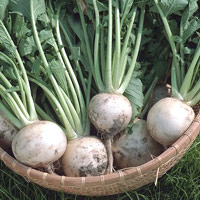Turnip

Relatively obscure in this country, turnips are a staple in many European kitchens.
About This Plant
Turnips mature in about 2 months. Fall crops are usually sweeter and more tender than spring crops, and insects are less of a problem late in the season. Young turnips are so tender you can peel and eat them just as you would an apple. Many southern gardeners prefer to grow turnips for the greens. Both the roots and greens are very nutritious. To stretch the turnip harvest over a 2- or 3-month period, plant two or three varieties in the first planting. The roots will mature at different times instead of all at once. You can also harvest some turnips very early as greens, and small roots for eating fresh. Any turnip can be grown for its greens if harvested young, so you don't need to plant special varieties, even if you want more greens than roots.
Site Selection
Select a site with full sun and well-drained soil. Prepare the garden bed by using a garden fork or tiller to loosen the soil to a depth of 12 to 15 inches, then mix in a 2- to 4-inch layer of compost.
Planting Instructions
For best results, sow spring crops as soon as the soil can be worked. Broadcast turnip seed over a well-tilled bed. Rake to cover seeds with 1/2 inch of soil or use a tiller set on shallow to bury the seeds.
Care
Do not thin if growing turnips for greens only. For turnip roots, thin seedlings to stand 2 to 4 inches apart when they are 4 inches high. Water deeply once a week (about 1 inch of water at a time) so the roots don't become tough and bitter. Mulch heavily. Contact your local County Extension office for controls of common turnip pests such as root maggots.
Harvesting
Harvest turnips at any size during the growing season. In the fall, dig mature roots before the ground freezes and store them in a cool place.






 Relatively obscure in this country, turnips are a staple in many European kitchens.
Relatively obscure in this country, turnips are a staple in many European kitchens.